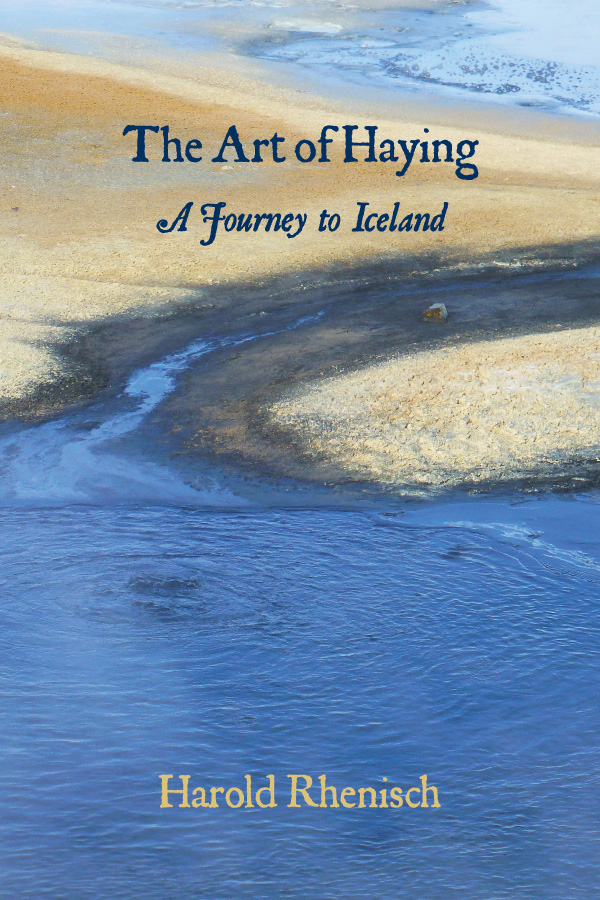Harold Rhenisch

When Harold and Diane Rhenisch went to Iceland in 2010, Harold had just returned from a pilgrimage on the via regia, the 1000-year-old “King’s Way” through East Germany. Diane sat on her bed the next night on Iceland’s south coast and announced that she was staying there forever. Harold agreed that he wanted to stay, too. This book came from that trip — a love story set within the bond between Icelanders, their sheep and their horses. Harold soon learns to give up the books he loves for Icelandic nature and people. And trolls. The pair drive down all kinds of impossible roads to meet the local trolls. Trolls, Harold notes, keep humans because humans keep sheep, and trolls like sheep. So does Harold. At first, he is troubled by this. Then he learns to laugh. The Art of Haying follows our couple on three trips of renewed love to Iceland, in summer, winter and spring. As Harold trudges after Diane to an enchanted cave on Iceland’s eastern shore, he sees her as a different woman than he has ever known before. He has the smarts not to let her out of his sight. He is soon happily unravelling the threads of his language, English, until he begins to describe it as Icelandic with a bad accent and a lot of stolen words. As the two enchanted travellers dive into knitting shops and walk out with herds of sheep in the rain, Harold begins to describe how the knitting traditions of iceland translate sheep wandering across the Icelandic Highlands in skeins of rain into the special kind of love charm called the Icelandic Sweater, knitted by Icelandic women to keep their men and children warm in the cold. Harold chats with ravens in the north, and is eyed by others as they skip along a canyon rim in a snow-bound fjord in the East, waiting for him to stumble and become lunch. After a month as writer in residence at Skriduklaustur, writing about the modern sagas of the Icelandic writer Gunnar Gunnarsson, he adopts Gunnarsson’s blend of poetry, fiction and nonfiction as his own. The result is a love story for Iceland and story telling, both ancient and for a new age of the world in which books are less vital than a visual and spiritual feast of experience, nature, art and creativity: in other words, Iceland. Then the horses come, and Harold goes out to them. He does not come back.
“There are prose works married to image that redefine the way we think of language and its visual correlatives. Bento’s Sketchbook, by John Berger; Kathleen Jamie’s Frissures, with Brigid Collins — windows thrown open to unexpected places. The Art of Haying is one of these books. Its windows look out to Iceland, its farms, its trolls and horses, and the curve of its hayfields created out of craters and rain. Read it for its weather and its lyrical attentions. ‘Words, words, words, words, words. You may, if you want, listen. You may, if you wish, hear yourself think. You may, if you go out into the dark, hear the crackle of the Aurora over Husavik when the sun has gone down behind the hill.’ Every page is memorable, even in the dark.”
~ Theresa Kishkan, author of Mnemonic: A Book of Trees
Harold Rhenisch is the author of 28 books of memoir, literary nonfiction, environmental writing, poetry, fiction, translation and essay. His Out of the Interior and Tom Thomson’s Shack are classics of literary memoir. His pioneering work at adapting European literary nonfiction styles to Canadian experience has earned him the George Ryga Prize, four B.C. Book Prize nominations, and a reputation as a go-to editor for nonfiction memoirs that bridge genres, including Phyllis Nackomeckny’s Vidh, Lorne Dufour’s Joseph’s Prayer and Vangie Bergum’s Bestamor and Me. He has won the Malahat Review long poem prize (twice), a CBC Poetry Prize, and national and regional prizes for poetry, book reviewing and playwriting. He works closely with environmental photographer and publisher Chris Harris and writes (and photographs) the environmental blog www.okanaganokanogan.com. He likes to describe his home, the Okanagan Valley in the dry grasslands of the Canadian West, as Iceland without rain.
ISBN 978-1-77171-125-8
Travel/Meditations, with photographs
200 pages
6 x 9
$33.95
Now available
customers
customers
customers